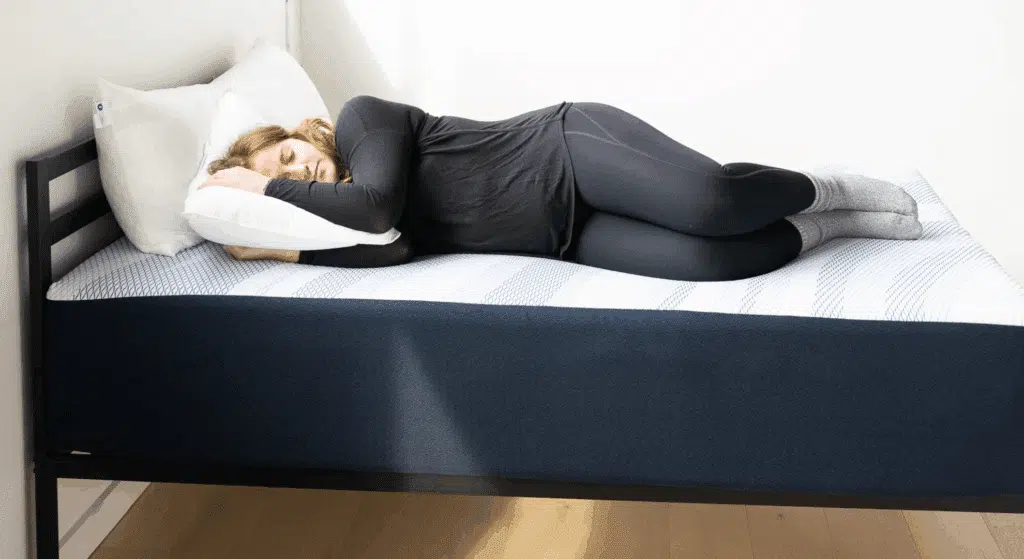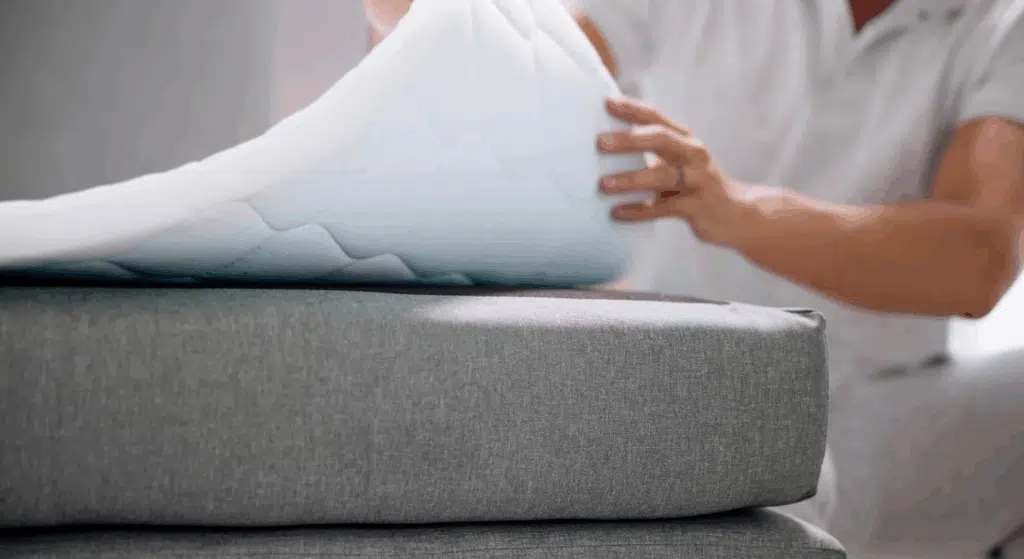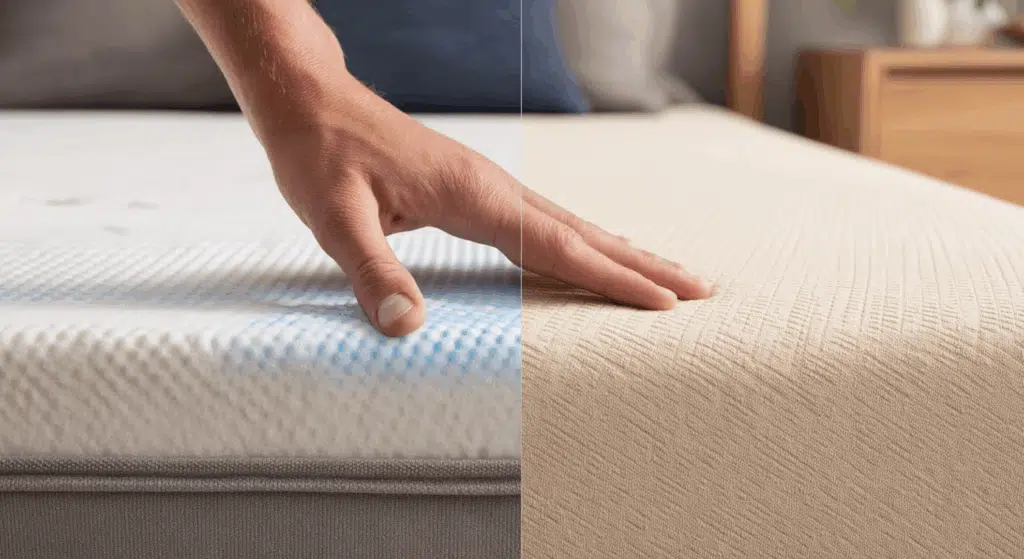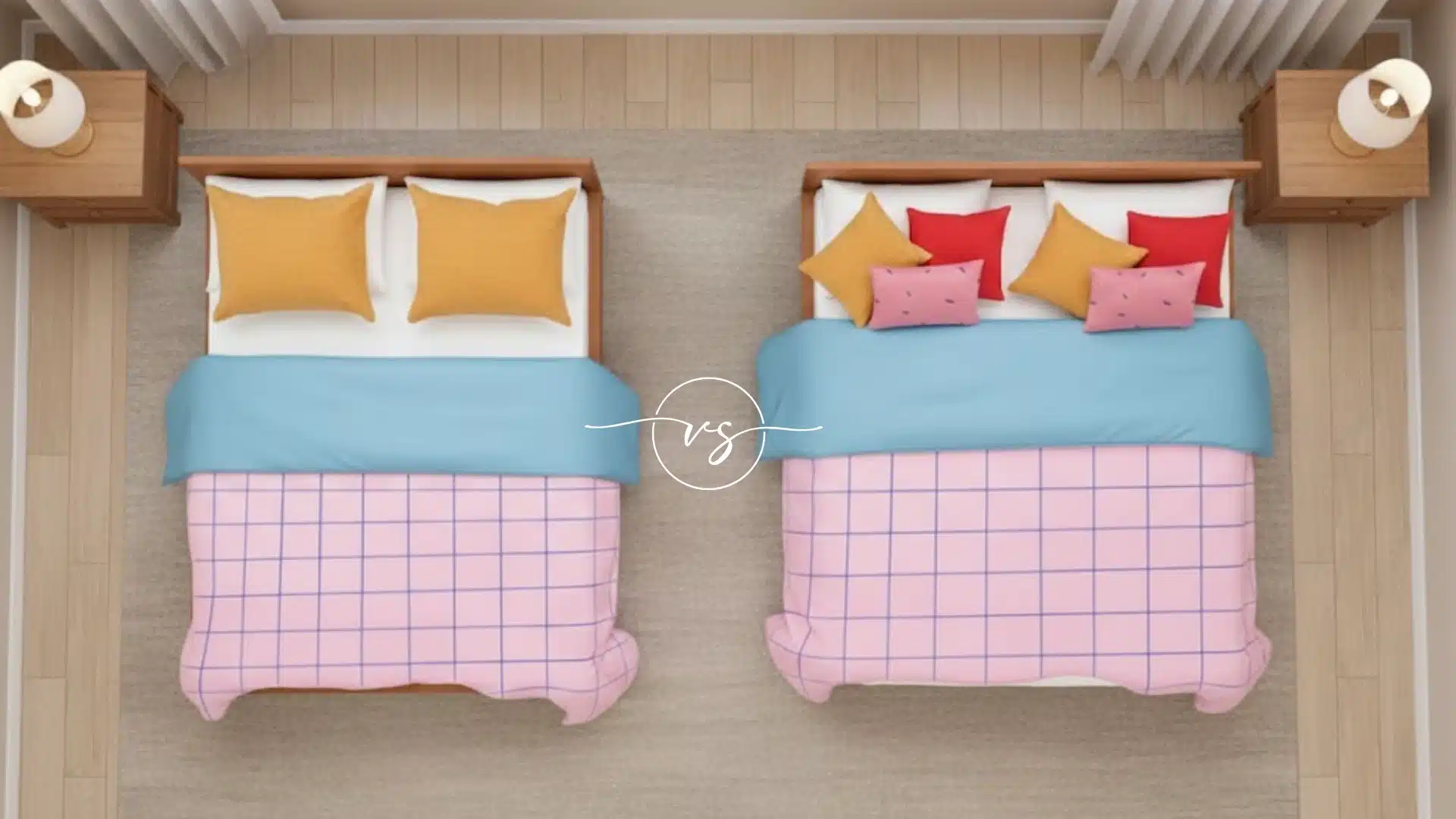Some nights I wake up too hot. Other times, I notice my back feels stiff in the morning. I used to think all foam mattresses were the same, but learning about gel memory foam vs. memory foam changed that.
Once I figured out how they react to heat, pressure, and movement, I finally understood what my body actually needed.
In this guide, you’ll get the same clarity. You’ll see how each foam type works, what it’s made of, and which one fits your sleep style. No matter if you deal with back pain, restless nights, or just want better comfort, this will help you choose the right kind of mattress for your needs, without confusion.
How Memory Foam Technology Works?
Memory foam changes when it feels heat and pressure. When you lie on it, your body warmth makes the foam softer. The foam then molds around your shape. Once you get up, it slowly goes back to its normal form. That’s why it feels like it “remembers” you.
There are two main kinds of memory foam: open-cell and closed-cell.
- Open-cell foam lets air move through it. This keeps the foam cooler and more breathable.
- Closed-cell foam traps air inside. This makes it firmer and warmer.
Memory foam was first made by NASA in the 1960s. They wanted to make seats safer and more comfortable for astronauts during flights. Over time, the same idea was used in beds, pillows, and even shoes. Today, people love memory foam because it supports the body and helps with comfort.
It’s a simple idea, but it’s changed how we sleep and rest.
What is Gel Memory Foam and How Is It Made?
Gel memory foam is a kind of memory foam that has cooling gel added to help lower heat. Regular memory foam can trap heat, but gel helps pull heat away from your body.
There are a few types of gel used:
- Gel beads are small drops of gel spread through the foam.
- Gel swirls are mixed in like a pattern.
- Phase-change materials melt when they get warm, soaking up heat, then cool down as they turn solid again.
Gel infusion means the gel is mixed into the foam during the making process. It can be added to the top layer or spread throughout the foam. This helps improve airflow and keeps the surface cooler.
Cooling gel memory foam still has the slow-moving feel of memory foam. Gel-infused polyfoam feels bouncier and doesn’t mold around the body as much. So the feel and support are different.
Gel Memory Foam vs. Memory Foam: Side-by-Side Comparison
Both memory foam and gel memory foam give support and comfort. But they work in slightly different ways. Here’s a quick look at how they compare across important features:
| Feature | Memory Foam | Gel Memory Foam |
|---|---|---|
| Cooling | Traps more heat. Best for people who don’t get too warm at night. | Stays cooler. Good for hot sleepers. |
| Response Time | Slow to bounce back. Good for deep, still rest. | A bit quicker. Great for people who shift during sleep. |
| Firmness Options | Comes in soft, medium, and firm. | Similar firmness levels, but may feel slightly firmer. |
| Motion Isolation | Very good. Ideal for light sleepers. | Also very good. Great for couples. |
| Pressure Relief | Excellent support for joints and back. | Same support, with a cooler feel. |
| Durability | Lasts around 7–10 years. | Similar lifespan, depending on quality. |
| Price Range | Often less expensive. Good for budget shoppers. | Usually a bit more. Best for those who want cooler sleep. |
Both types work well, but your choice depends on what matters most: cooling, bounce, or budget.
Which Type of Foam is Better for You?
Choosing between gel memory foam and traditional memory foam depends on how you sleep, what comfort feels best to you, and what kind of support your body needs. Here’s a simple guide to help you decide.
1. If You Sleep Hot

Best pick: Gel memory foam
If you often wake up hot or sweaty, gel memory foam is the better choice. It’s made with cooling materials like gel beads or swirls that pull heat away from your body.
This helps you sleep cooler through the night. It’s especially helpful for people living in warm places or anyone dealing with hot flashes or night sweats.
Traditional memory foam holds onto body heat, so it’s not a good fit for hot sleepers. If cooling matters, stick with gel foam.
2. If You Need Strong Back or Hip Support

Best pick: Traditional memory foam
Traditional memory foam gives deep, even support that helps keep your spine straight. It hugs your body, easing pressure on your back and hips. This can be helpful if you have chronic pain or sore joints.
The slower feel lets your body fully relax and settle into the bed. Gel foam can also support you well, but it may feel firmer or a bit more springy. For deep contouring and pain relief, traditional foam is usually the better pick.
3. If You Change Positions Often

Best pick: Gel memory foam
Gel memory foam reacts faster than traditional foam. That means when you roll over or shift around, it bounces back quickly. You don’t feel stuck in one spot.
This makes it easier for restless sleepers to get comfortable. If you move around a lot at night, gel foam helps you stay comfy without slowing you down.
Traditional foam is slower to respond and may feel too sticky or stiff, especially for people who toss and turn while sleeping.
4. If You Sleep on Your Side

Best pick: Traditional memory foam (medium-soft)
Side sleepers need a bed that cushions the shoulders and hips. Traditional memory foam does this really well, especially in soft to medium versions.
It gives a gentle sink that helps keep your spine in a straight line while lying on your side. This is great for people who sleep in a curled-up or fetal position.
Gel foam can also work if it’s soft enough, but some gel models may feel too firm or not allow enough sink at pressure points.
5. If You Share a Bed

Best pick: Both are good, but traditional memory foam edges out slightly
If your partner moves around a lot, both gel and traditional memory foam help stop the movement from reaching your side.
But traditional foam tends to do just a little better because it responds more slowly, soaking up the motion. Gel foam is still great, especially if it’s dense.
For the best motion control, pick a higher-density foam in either style. You’ll both sleep better without waking up every time the other person moves.
6. If You’re on a Budget

Best pick: Traditional memory foam
Traditional memory foam is the better pick if you’re trying to save money. It’s often cheaper in every mattress size and still offers solid comfort and support.
You’ll find more budget-friendly brands and sales with regular memory foam. Gel memory foam costs more because of the added cooling features.
If you don’t need cooling or if you sleep fine in a warmer bed, traditional foam gives you what you need without spending extra. It’s a smart pick for tight budgets.
Higher-density foam (around 4–5 lb/ft³) lasts longer and gives better support, no matter which type you choose.
The best mattress for you depends on how you sleep and what your body needs. Use this guide to match your comfort style to the right foam type.
How to Choose Based on Sleeping Position
Your sleeping position plays a big role in picking the right foam. Here is some help to guide you in deciding which one would work best for you.
Side sleepers need a soft to medium foam that allows shoulders and hips to sink in. This helps ease pressure and keeps your spine straight. Gel memory foam works well here because it molds to your shape and stays cool.
Back sleepers do best with medium-firm foam. The foam should support the lower back while keeping the spine in line. Both memory foam and gel memory foam can work, but a firmer option is better to avoid sinking too deeply.
Stomach sleepers need a firm foam that holds up the chest, belly, and hips. If the foam is too soft, the body may dip, which can hurt the lower back. Firmer gel memory foam or high-density memory foam is a good fit.
In short, your sleep position should guide how soft or firm the foam should be—and cooling may be an added bonus.
Pros and Cons of Gel vs. Traditional Memory Foam
Gel memory foam and traditional memory foam each work well for comfort and support, but they don’t feel the same. One stays cooler, while the other hugs the body more. The table below shows the main pros and cons of each type:
| Type | Pros | Cons |
|---|---|---|
| Traditional Memory Foam | – Great pressure relief – Very quiet – Good for motion isolation | – Traps heat – May feel too soft for some – Slower response time |
| Gel Memory Foam | – Feels cooler – Faster response – Same pressure relief as regular foam | – Often more expensive – Cooling may wear out – Can feel firmer |
So which one is better? It depends on what bothers you most—heat, lack of support, or cost. Use this table to match the foam type with your sleep needs.
Hybrid Options: Is There a Middle Ground?
If you’re looking for comfort and support in one mattress, a hybrid could be a smart pick. Hybrid mattresses mix memory foam with pocketed coils to give you the best of both worlds. The foam cushions your body, while the coils lift and support it.
When gel memory foam is added to the top layer, the mattress becomes even cooler. The gel pulls away heat, while the springs below let air flow more freely. This combo helps people who sleep hot or need extra back support without giving up softness.
Hybrids feel more responsive than all-foam beds. They bounce back faster and are easier to move around on. While they may cost more than simple memory foam beds, they give added support and tend to last longer.
So if you want the pressure relief of foam with better airflow and stronger support, a hybrid mattress is a solid middle choice.
Signs You Should Replace Your Current Mattress
Even the best foam mattresses wear out over time. Whether it’s gel or traditional memory foam, there are clear signs it’s time for a new one. If your bed isn’t giving you comfort or support like it used to, pay attention to these warnings:
- You wake up with new aches or soreness
- The mattress feels lumpy or uneven
- You notice deep sagging where you sleep
- It takes longer for the foam to bounce back
- You feel warmer at night due to heat buildup
- The edges of the bed feel soft or unstable
- You can feel your partner’s movement more than before
If you notice two or more of these signs, it’s probably time to replace your mattress. Foam, especially gel memory foam, can break down after years of use—even if it still looks fine on the outside. Comfort and support should always come first.
Conclusion
I used to think all foam mattresses were pretty much the same, until I learned the real differences between gel memory foam vs. memory foam. Once I paid attention to how I slept, what felt good, and what didn’t, everything started to make more sense.
Cooling, support, and pressure relief all play a bigger role than I thought.
Now it’s your turn to take what you’ve learned and use it. Think about how your current mattress feels. Are you sleeping well? Does it support your body the way it should? If not, it might be time to make a change. One last thing, don’t rush the decision. A better night’s sleep is worth the time.
Keep going. Check out other blogs on the website to learn more and make smarter choices for your sleep!









